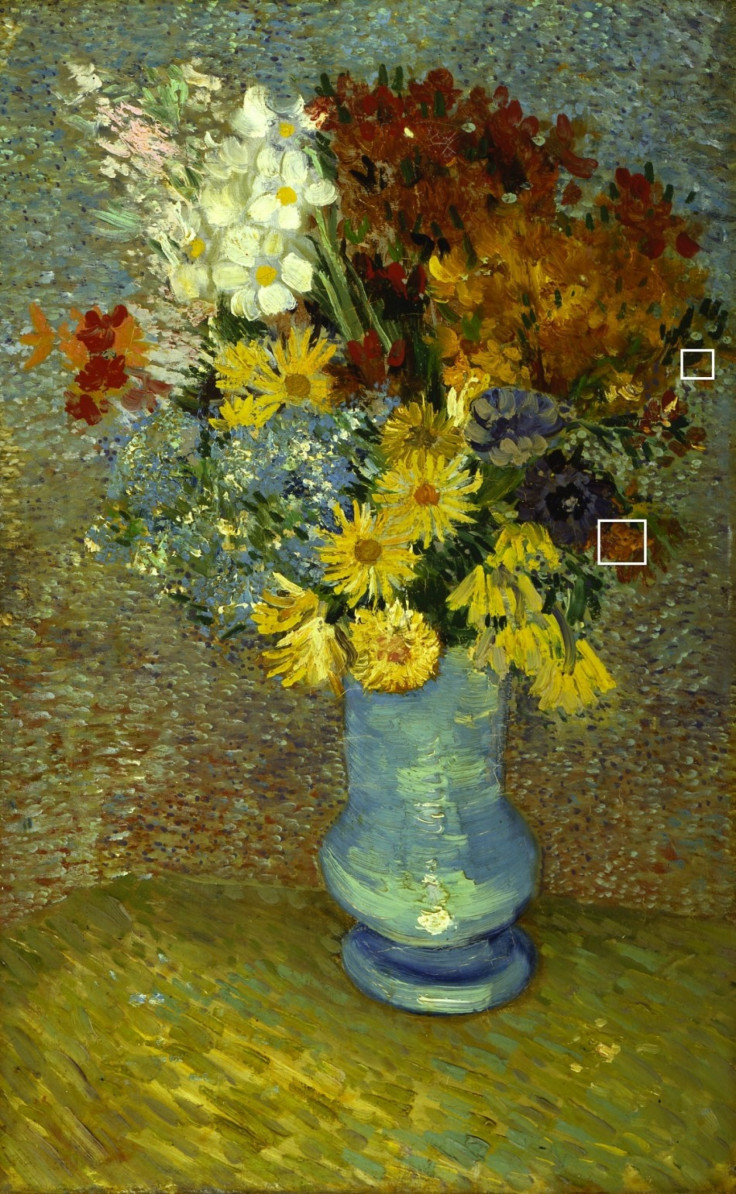Van Gogh Painting's Color-Changing Flowers Demystified By Chemists

What makes a painted flower wilt? A group of chemists think that a museum-applied varnish is the reason that a Vincent Van Gogh painting has become oddly discolored with age.
"Flowers in a blue vase" was painted by Van Gogh in 1887. It was later acquired by the Kroller-Muller museum, a Dutch institution with the second-largest Van Gogh collection in the world. But over time, some of the bright yellow flowers in the painter's bouquet have turned an orange-gray color.
In a paper published in the journal Analytical Chemistry, an international team led by University of Antwerp researcher Koen Janssens says that the color change is the result of a previously undocumented kind of chemical degredation caused by an interaction between the paint applied by Van Gogh and a protective varnish applied by the museum in the early 20th century.
Van Gogh used a cadmium yellow oil paint that was relatively new at the time. In unvarnished works, the air causes it to oxidize, making it lose color and form a slightly off-white layer on top. But the researchers had never seen a gray, opaque coating like the one on "Flowers in a blue vase" before.
To diagnose just what happened with their painting, the museum sent tiny samples of paint from the affected areas to the scientists, who examined the chemical composition of the samples with powerful X-rays. They found that cadmium ions from the oil paint had combined with bits of the varnish itself to make a compound called cadmium oxalate, while sulphate ions from the paint interacted with lead from the varnish to make a compound called anglesite. Together, the cadmium oxalate and anglesite account for the discoloration.
It's still not clear whether removing varnishes and crusts from paintings would be the right way to restore the Van Gogh painting and others like it, since the crust contains bits of the original yellow paint.
"Once again, we find that paintings by Vincent van Gogh are not static entities for decades and centuries to come," Janssens said in a statement Friday. "Over a period of 100 years, they can actually be considered a fairly reactive cocktail of chemicals that behaves in unexpected manners."
According to Ella Hendriks, head of conservation at the Van Gogh Museum in Amsterdam, who was not involved in the current paper, the work will lead to better preservation of the master's works.
"Many of Van Gogh's French period paintings have been inappropriately varnished in the past, and removal of these nonoriginal varnish layers is one of the challenges facing conservators on a worldwide basis today," Hendriks said in a statement Friday. "The type of information provided by Janssens and his team is vital to support the difficult decisions that conservators often have to make regarding such complex cleaning treatments."
Chemists aren't the only scientists that are taking inspiration for research from Van Gogh. In March, biologists unlocked the genetic secrets of the puffy, "double-flowered" mutant sunflower that appears in several Van Gogh paintings.
SOURCE: Van der Snickt et al. "Combined use of synchrotron radiation-based µ-XRF, µ-XRD, µ-XANES and µ-FTIR reveals an alternative degradation pathway of the pigment cadmium yellow (CdS) in a painting by Van Gogh." Analytical Chemistry published online 30 August 2012.
© Copyright IBTimes 2025. All rights reserved.





















